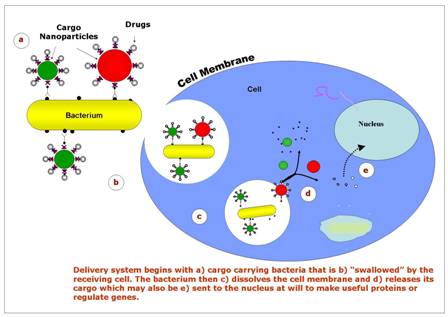|
|
|
| Nanotechnology, diagnostics | |
Bacteria place nanoparticles in cells to aid diagnosis or treatment18 June 2007 The natural infection mechanism of bacteria can be used to deliver nanoparticles carrying drugs, DNA or sensors into cells for precise diagnosis or treatment of disease. The new approach was developed by researchers at Purdue University in the USA. It is a potential way to overcome hurdles in delivering cargo to the interiors of cells, where they could be used as an alterative technology for gene therapy, according to Rashid Bashir, a researcher at Purdue's Birck Nanotechnology Center. In developing the technique, the researchers attached nanoparticles to the outside of bacteria and linked the DNA for a fluorescent protein to the nanoparticles. Then the nanoparticle-laden bacteria transported the DNA to the nuclei of cells, causing the cells to produce a fluorescent protein that glowed green. The same method could be used to deliver drugs, genes or other cargo into cells.
"The released cargo is designed to be transported to different locations in the cells to carry out disease detection and treatment simultaneously," said Bashir, a professor in the Weldon School of Biomedical Engineering and the School of Electrical and Computer Engineering. "Because the bacteria and nanoparticle material can be selected from many choices, this is a delivery system that can be tailored to the characteristics of the receiving cells. It can deliver diagnostic or therapeutic cargo effectively for a wide range of needs." Harmless strains of bacteria could be used as vehicles, harnessing bacteria's natural ability to penetrate cells and their nuclei, Bashir said. "For gene therapy, a big obstacle has been finding ways to transport the therapeutic DNA molecule through the nuclear membrane and into the nucleus," he said. "Only when it is in the nucleus can the DNA produce proteins that perform specific functions and correct genetic disease conditions." When the cargo-carrying bacteria attach to the recipient cell they are engulfed by its outer membrane, forming "vesicles," or tiny spheres that are drawn into the cell's interior. Once inside the cell, the bacteria dissolve the vesicle membrane and release the cargo. One application of the technique is to detect and precisely locate tumours. It could insert fluorescent molecules into tumours that are ordinarily too small to be detected, said Demir Akin, a research assistant professor of biomedical engineering who specializes in nanomedicine. "These bacteria can potentially deliver specific molecules into a variety of cells," said Akin, the first author of a research paper appearing online this week in the journal Nature Nanotechnology. Experiments were carried out in cultures of human cancer cells, including intestinal, oral, liver, ovarian and breast cancer cells. The researchers also tested their method on live mice and showed how the technique could be used to deliver specific genes to various organs, including the liver and kidneys. "The use of commercially available polystyrene nanoparticles makes this delivery system much simpler to implement than previous alternatives," Bashir said. This new delivery system also is more efficient than other experimental techniques using viruses and bacteria. "With other techniques, you can usually incorporate only one copy of your gene cargo to each bacterium or virus particle," Akin said. In the new approach, bacteria can carry hundreds of nanoparticles, each of which can in turn carry hundreds of drug molecules, depending on the size of the nanoparticles. Inserting sensors The approach also could make it possible to insert relatively large structures, such as sensors and hollow filaments called carbon nanotubes, into the interiors of cells. The sensors could make it possible to monitor activities inside a single cell for the early detection of cancer and other diseases and to monitor the progress of disease and response to drug therapy. The carbon nanotubes could be delivered into diseased cells and then exposed to light, causing them to heat up and kill only those diseased cells, Akin said.
|
